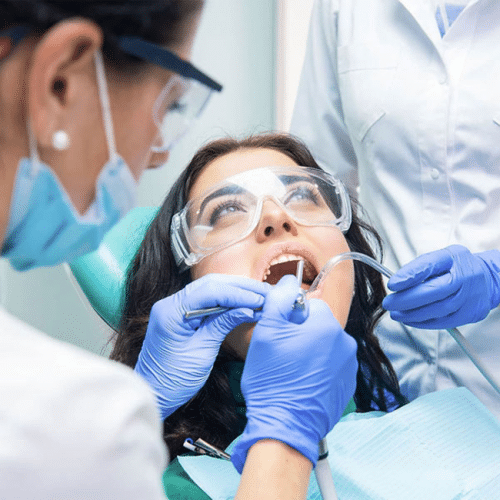Bone Grafting Dublin
For dental implant treatment the jawbone that receives the titanium posts will need to be in a suitable condition. A good jawbone structure provides a stable foundation for dental implant fixtures to support replacement teeth.
There are differences between upper and lower jawbone quality. Lower jawbone is comprised of denser bone quality than the upper jawbone, which is of a softer build. Teeth that are removed will leave a tooth gap, which over time can succumb to resorption, causing bone loss and making it harder to replace the missing tooth.
The best time to insert dental implants into a tooth extraction site is about six to eight weeks after the extraction.
During this period of time bone loss will not yet have occurred, but the oral tissue around the extraction site will have healed and any infection will be gone. The tooth extraction site will therefore be healthy enough to receive the dental implant fixtures.
At Smile Hub an implant dentist will initially examine your jawbone structure using diagnostic imaging tests, such as X-rays and CT scans. Part of the assessment is to evaluate bone density and determine if:
- There is sufficient jawbone structure and density to receive a dental implant.
- Dental implants can be inserted without the need for bone grafting.
- The bone structure is suitable enough for simultaneous bone grafting and a dental implant.
- Bone augmentation is necessary using a bone graft to strengthen the jawbone region.
If the evaluation identifies that sufficient bone structure and enough bone density is present, the oral surgeon will recommend proceeding with dental implant treatment without the need for bone grafting. However, this will depend on the quality and quantity of the existing jawbone.
If the jawbone structure is not strong enough and bone grafting is necessary, your dentist in Smile Hub may recommend simultaneous bone graft and dental implant treatment. A Bio-Oss or bovine-derived bone graft and Bio-Gide or porcine-derived membrane will be obtained, and used for bone augmentation to expand the jawbone. Once the bone graft is fused into the jawbone structure during the operation, incisions are then made and the titanium dental implant posts inserted, ready to receive replacement teeth.
However, if the jawbone structure is weak bone augmentation will have to be done first, with a healing period of six months before implant treatment can proceed. If the patient’s bone is not used for harvesting and bone graft, a human cadaver bone graft, or Bio-Oss bovine-derived bone graft and Bio-Gide porcine-derived membrane, may be used.
A bone graft from a patient’s own mouth or tibia is less likely to be rejected by the body. Bone grafts from sources other than the patient have a chance of rejection or failure, measured at approximately 25 percent. Other risks associated with bone grafts are infection or bone graft shifting. These risks are mitigated through clinical expertise and, where necessary, procedures may be redone or re-treated. Alternate treatment options for missing teeth may also be considered, such as dentures or bridges.
At Smile Hub your dentist may recommend bone grafting if the jawbone is too weak to hold dental implants without damage. Through bone augmentation the jawbone is sufficiently strengthened for healthy dental implant placement. Patients have choices in the type of bone graft that is used, which includes their own, human cadaver bone, bovine-derived bone or synthetic bone that is not of human or animal origin.
There are medical and dental cases where bone grafting is the most appropriate means to save degenerating bone structure. If the bone structure is not built up through bone grafting, patients may experience bone fractures, breaks and severe pain. Nearby tissues containing blood vessels and nerves may become traumatised. Bone augmentation is a way of maintaining proper oral and overall health, eliminating pain and discomfort.
Cases where there is not enough space between the sinus cavity and upper jawbone may require a sinus lift bone augmentation. The sinus lift raises the sinus membrane into the sinus cavity, so that there is enough space to insert dental implants safely without impinging on the sinus cavity or cause potential damage.
Bone grafting is necessary where insufficient jawbone structure is present to fully hold the dental implants and prevent thread exposure. Although wearing a removable gum mask to hide exposed implant threads is an option, it does not correct the underlying jawbone weakness. Patients leaving implant threads exposed may experience sensitivity, pain and complications over time.
Those with such conditions should seek treatment to correct dental implant placement and jawbone quality. If left untreated patients may not only experience oral health complications, but also knock-on neurological and vascular effects. Through the treatment of bone loss patients reduce the risk of oral diseases, associated medical conditions and improve health.

























